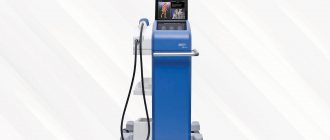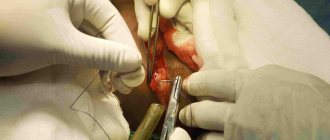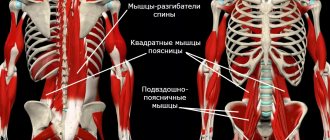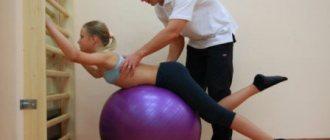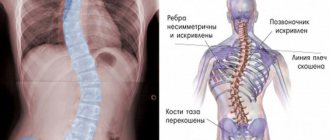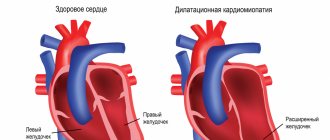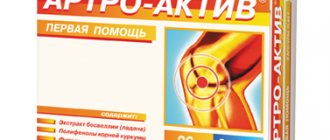One day hospital 3rd KO
Malykhin
Sergey Aleksandrovich
11 years of experience
First qualification category
Make an appointment
Lordosis in its original understanding is a physiological, that is, a necessary forward bend of the spine. Normally, it should be in both the lumbar and cervical regions. But often this word is used when they want to talk about pathological changes - too pronounced or, on the contrary, smoothed lordosis. This problem can be acquired, as well as congenital - it occurs in different age groups, and often depends on the person’s lifestyle. We will talk about the pathological condition of the spine.
Reasons for development
The main causes of the disorder are damage to the vertebrae or pathology of the hip joints. Lordosis occurs as a result of:
- Developmental defects.
- Neoplasms.
- Inflammation.
- Spondylolisthesis.
- Torsion muscle spasms.
- Spinal injuries.
- Diseases such as polio, cerebral palsy, rickets.
- Systemic diseases that cause damage to muscles, cartilage, and bones.
- Poor posture during pregnancy (a temporary phenomenon that goes away after the birth of the child).
Pathological lordosis of the spine can occur in children for no apparent reason. This condition is corrected as the child grows older and does not leave any health consequences.
Consequences
The development of lordosis at the chest level poses a danger to the body:
- decreased tidal volume of the lungs;
- difficult heart function;
- the likelihood of kidney prolapse;
- pain between the ribs due to their deformation;
- decreased shock absorption properties of the spine;
- increased fatigue, intolerance to heavy loads;
- deterioration of nerve conduction of organs.
Health problems can also arise with the development of hyperlorosis, which also requires the attention of a specialist.
Symptoms
The most common symptom of spinal lordosis is muscle pain. Curvature provokes muscle tension and spasms. Cervical lordosis causes discomfort in the neck and shoulder area. You should visit a doctor if the following symptoms appear:
- There are restrictions on mobility in the cervical or lumbar region.
- Numbness and tingling appear.
- Sharp pain, also called lumbago.
- Bladder control problems.
- Muscle weakness.
Preventive measures
Is it possible to prevent lumbar lordosis? If it’s not innate, then it’s fine. The best prevention is considered to be an active lifestyle, monitoring your health, following nutritional rules, and exercising.
Exercises are done in the morning, and regularly, and not occasionally. Going to the gym or fitness club is also welcome, you just need to monitor the loads and follow the technique of working with equipment.
Exercising in the morning as a way to prevent spinal curvature
Prevention will be helped by following a regimen, healthy eating, proper rest and sleep (for which you need to purchase a hard mattress and an orthopedic pillow).
Adequate rest on an orthopedic mattress and pillow helps maintain spinal health
If your job is sedentary, be sure to control your posture. In between, hang on the horizontal bar or otherwise warm up.
Charging at work
Types of lordosis
The classification involves different types, taking into account key parameters:
- Localization:
- Cervical lordosis.
- Lumbar lordosis.
- Causes:
- Primary, resulting from pathologies of the spine.
- Secondary – deformation of the spine as a consequence of the body’s adaptation to balance in atypical conditions.
- Possibility of full recovery:
- Unfixed – it is possible to straighten the back with a conscious effort.
- Partially fixed - there are restrictions on changing the bending angle.
- Fixed – without the possibility of restoring the normal position of the back.
A separate form of the disease is smoothed lordosis. This brings maximum trouble. Smoothness implies the absence of natural curves of the spine, that is, the back is completely straight. When lordosis is strengthened, the curvature of the spine, on the contrary, becomes significantly more pronounced.
Main symptoms of the disease
Straightening the natural curve in the lower back does not go unnoticed. Already in the early stages, the patient notices changes in posture, difficulties with full alignment of the back and other negative signs. The main ones are:
Physiological curves of the spinal column
- Sharp pain in the lower back.
- The appearance of numbness in the morning in the damaged area.
- On palpation, a tightness is felt in the lower back.
- A forward tilt of the body that is difficult to correct by standing straight.
- Constant feeling of fatigue or decreased performance.
The lumbosacral region moves forward, and the gait changes greatly for the worse. The stomach protrudes slightly, the chest becomes sunken, the head is tilted forward. Some patients complain of severe pain in their legs. Degenerative processes that occur in the spine cause serious diseases, which in the future affect the functioning of the entire body.
What is the danger of the disease
The spine is the foundation of the entire body. Any of its pathological changes have a detrimental effect on the functioning of individual organs and the body as a whole. Mainly organs in those areas where the curvature is localized are affected. Problems also affect the spine. Inflammation of the vertebrae, their destruction, prolapse, the appearance of hernias, osteochondrosis, deforming arthrosis with subsequent loss of performance are possible.
Diagnostics
Making a diagnosis requires a number of activities:
- Questioning the patient, identifying symptoms, compiling a medical history.
- Determination of spinal mobility, its curvature, and developmental anomalies.
- Conducting a neurological examination.
- X-ray, which will help to accurately determine the degree of curvature.
There is a self-diagnosis method that can be done at home. It certainly won’t give exact results, but it will help you get your bearings. You need to stand with your back to the wall and try to stick your hand in the lumbar area between the wall and your back. The hand should move with difficulty.
How is pathology detected?
The doctor identifies spinal deformity based on a visual examination of the patient and an x-ray examination (frontal and lateral projection). At the initial appointment, the peculiarities of posture are determined, tests are carried out to determine the nature of lordosis, and there are concomitant neurological disorders. To confirm the diagnosis, it is necessary to undergo standard blood and urine tests, as well as rheumatoid factor. In addition, instrumental research methods are also used:
- Magnetic resonance imaging.
- X-rays of light.
- ECG.
- CT scan.
- Ultrasound of the pelvis.
They allow you to determine the degree of development of lordosis, choose the appropriate treatment tactics, as well as the appearance of other disorders of the internal organs against the background of the disease.
X-ray is the most effective and fastest way to diagnose lordosis
Treatment
Most cases of pathological lordosis do not require medical treatment. In more severe situations, drug therapy is used. The action of drugs that can be used is aimed at relieving pain and inflammation. Among the main treatment methods:
- Physiotherapy.
- Exercises aimed at strengthening the back muscles, increasing mobility of the lower back and cervical spine.
- Losing weight is one way to improve your posture.
- A corset is an effective measure for children and adolescents.
- Taking vitamins, including vitamin D.
Surgical treatment is used only in the most severe cases in which conservative treatment cannot help the patient.
Fighting tactics
A degenerative change such as spinal flattening cannot be cured with pills. First of all, it is necessary to find the cause of such processes in the body. If you are overweight, a balanced diet is prescribed; if you are pregnant, you will be prescribed a corrective bandage. In general, a comprehensive approach is taken to eliminating symptoms and slowing down curvature processes.
Chondroprotectors are the basis for the treatment of any problems with the musculoskeletal system
Drug therapy
It is aimed at relieving pain and relieving the inflammatory process. The doctor selects appropriate medications individually, taking into account the patient’s age, his general health, the presence of concomitant chronic diseases, and other things.
The following medications are usually prescribed:
- Non-steroidal anti-inflammatory drugs (Diclofenac, Ibuprofen). They relieve pain, relieve swelling in the lower back, and are prescribed as needed.
- Painkillers (“Analgin”, “Ketonol”). If the pain is severe and does not go away after taking the pills, then a lidocaine blockade is prescribed. It allows you to stop the unpleasant syndrome for a long time and relieve you from unpleasant sensations for a long time.
- Chondroprotectors (“Donna”, “Teraflex”). With their help, the process of regeneration of cartilage tissue is accelerated. You can’t do without them if the problem is an intervertebral hernia
- Vitamin complexes. It is especially important that the composition contains group B, calcium, magnesium and other trace elements.
Drugs alone will not be enough to fight effectively, so along with them, the doctor prescribes exercises, visits to a chiropractor and physiotherapy. Only this approach allows you to get a good result and slow down negative processes in the spine, eliminating possible complications.
Physiotherapeutic activities
Physiotherapeutic procedures relieve static disturbances in the lumbar region as the disease develops, so they are prescribed in combination with exercises. The following techniques are of great benefit:
- Massage. It is carried out only during the period of remission by medical personnel with a sufficient level of qualifications. Helps normalize blood circulation and improve metabolic processes in the damaged area.
- Acupuncture. Eastern methods have long been famous for their effectiveness. The impact on acupuncture points helps to activate the restoration of natural processes that normalize the condition and restore the health of soft and bone tissues.
- Magnetotherapy. It is not prescribed to everyone, as it has a number of contraindications. But, like the others, it is aimed at improving the patient’s condition and restoring health.
All techniques require the session to be carried out only by qualified personnel, otherwise there is a risk of aggravating the problem. In addition to them, the patient is also recommended to take up swimming or yoga to strengthen the muscular frame of the back. Doctors usually prescribe exercise therapy when there is no compression of the cerebral roots.
Exercises for flattened lordosis
A smoothed curve in the lower back can be well treated with exercise therapy exercises. The complex itself is developed by a specialist. It is he who sets the number of approaches, duration of the lesson and its intensity. Here are some examples of how patients with this pathology are trained.
- The process always begins with preparation, warming up all muscle groups to properly prepare them for the upcoming load.
- Take a gymnastics stick and raise your arms high above your head. Gently bend in all directions, controlling your breathing and your own sensations. There should be no pain or discomfort.
- Lie on your back, bend your knees and try to pull them towards your chest as far as the stretch allows. Return to starting position.
- Without changing position, pull your knees to your chest, and then move them slightly to the side. Repeat the approach for the other side.
- Get on your knees and focus on your palms. Bend your spine upward, holding this position for 7 seconds. Then return to the starting position.
The session ends with light stretching to prevent injury to the warmed muscles. If you feel severe pain, discomfort, or dizziness during the process, stop training. This usually happens if the execution technique is violated, thereby causing an exacerbation.
Therapeutic gymnastics is carried out only under the supervision of medical personnel
